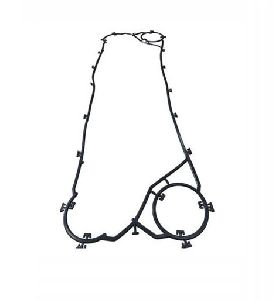
Rubber Flange Gasket
250 - 2,500 Per Piece
50 Piece(s) (MOQ)
Sandhya Enterprises Manufacture and Supplier of Rubber Falnge Gasket as per ASA 150#, PN10 and PN16. 25mm id to 1000mm ID A flange rubber gasket, also known as a flange gasket or flange seal, is a ring or sheet made of rubber or elastomeric material that is placed between two flange surfaces to create a seal. Flange gaskets are commonly used in piping systems, machinery, and equipment to prevent leakage of fluids, gases, or other substances at the connection points between flanges. Here are some key features and characteristics of flange rubber gaskets: 1. Material: Flange rubber gaskets are typically made from various types of rubber or elastomeric materials, such as neoprene, EPDM (ethylene propylene diene monomer), Nitrile (NBR), silicone, or Viton®. The choice of material depends on the specific application requirements, including the type of fluid or gas being sealed, temperature range, chemical resistance, and pressure conditions. 2. Sealing properties: The primary function of a flange rubber gasket is to provide a reliable and tight seal between two flange surfaces. The gasket is compressed between the flanges, creating a barrier that prevents fluid or gas leakage. The rubber material forms a conformable seal, allowing it to fill in irregularities and imperfections in the flange surfaces. 3. Compression and recovery: Flange rubber gaskets are designed to withstand compression when the flanges are tightened together. The gasket material should have sufficient elasticity and resilience to recover its shape and maintain the seal, even after repeated compressions and decompressions. 4. Temperature and chemical resistance: The choice of rubber material for a flange gasket depends on the temperature range and chemical compatibility of the application. Different rubber compounds offer varying degrees of resistance to heat, cold, chemicals, oils, fuels, and other substances. It is essential to select a gasket material that can withstand the specific environmental conditions. 5. Size and shape: Flange rubber gaskets are available in various sizes, shapes, and thicknesses to match different flange designs and specifications. The gaskets can be circular, oval, rectangular, or custom-shaped to fit specific flange configurations. 6. Industry standards: Flange rubber gaskets should comply with industry standards and specifications to ensure their compatibility and performance. Common standards include ANSI (American National Standards Institute), ASTM (American Society for Testing and Materials), and DIN (Deutsches Institut für Normung). 7. Customization: Flange rubber gaskets can be customized to meet specific application requirements, including dimensions, hardness, surface finishes, and additional features such as perforations or metal inserts for reinforcement. Proper selection and installation of flange rubber gaskets are crucial to ensure an effective seal. Factors such as flange design, bolt torque, and gasket thickness should be considered to achieve the desired sealing performance. Consulting with reputable gasket suppliers or manufacturers, who can provide guidance on material selection and gasket specifications based on the specific application requirements, is recommended to ensure the proper sealing solution.

Plate Heat Exchange Rubber Gaskets
1,000 - 5,000 Per no
1 no (MOQ)
Best Deals from Rubber Gaskets